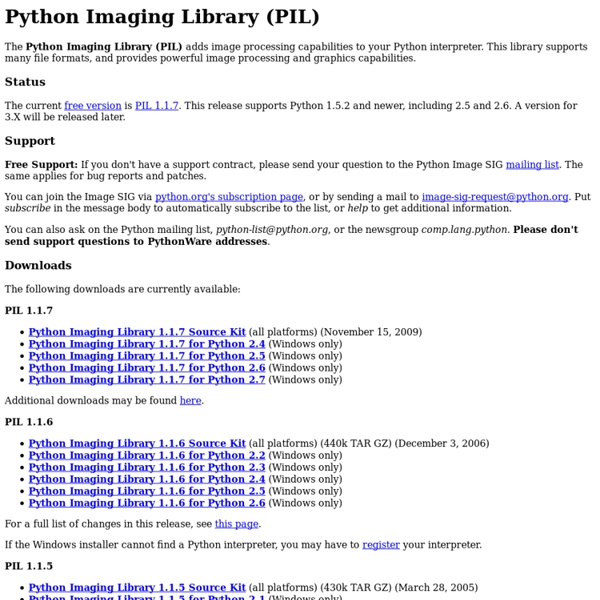Django People
pybluez
PyBluez is an effort to create python wrappers around system Bluetooth resources to allow Python developers to easily and quickly create Bluetooth applications. PyBluez works on GNU/Linux and Windows XP (Microsoft and Widcomm Bluetooth stacks). It is freely available under the GNU General Public License. Documentation See the Documentation page. Mailing List / Contact Please use the mailing list at News Jan 19, 2014 Version 0.20 released. Oct 15, 2009 Version 0.17 released. Feb 5, 2009 Version 0.16 released. Jan 21, 2008 Version 0.15 released. Jan 3, 2008 We are slowly transitioning the website from MIT (org.csail.mit.edu/pybluez) to Google Code ( Nov 12, 2007 Version 0.14 released. Aug 30, 2007 Version 0.13 released. Aug 29, 2007 Version 0.12 released. Aug 25, 2007 Version 0.11 released. Aug 15, 2007 Version 0.10 released. added experimental Broadcom/Widcomm support. Widcomm stack notes: 1. Dec 27, 2006 Version 0.9.2 released.
blist
The environment dictionary
A simple but integral aspect of Fabric is what is known as the “environment”: a Python dictionary subclass, which is used as a combination settings registry and shared inter-task data namespace. The environment dict is currently implemented as a global singleton, fabric.state.env, and is included in fabric.api for convenience. Keys in env are sometimes referred to as “env variables”. Below is a list of all predefined (or defined by Fabric itself during execution) environment variables. Note that many of these may be set via fab‘s command-line switches – see fab options and arguments for details. abort_exception Default: None Fabric normally handles aborting by printing an error message to stderr and calling sys.exit(1). Give it a callable which takes a string (the error message that would have been printed) and returns an exception instance. abort_on_prompts Default: False all_hosts Default: [] Set by fab to the full host list for the currently executing command. always_use_pty Default: True cwd
Hidden features of Python
PyPy :: PyPy
Installing Django on an Ubuntu Linux Server
Today I had the task of installing a development server running the Django Python framework for one of our web developers. I learned a few things and I figured a quick tutorial might help someone else out. None of this covers new ground, but perhaps another telling of the story will help someone out there. I started from scratch, with a basic install of Ubuntu 7.04 Server Edition. I did not choose any extra packages, such as the LAMP option or DNS server. If you are starting off with a LAMP server already installed, or a different version, the steps will be similiar, but you may need to adapt some commands to get them to work. Install server software Install Apache, Mod_Python, MySQL and MySQLdb. sudo apt-get install apache2 libapache2-mod-python sudo apt-get install mysql-server python-mysqldb Install the Django source code At this point you have a couple of options. cd ~/ svn co django_src Create Django’s directories Create a Django project
Centrifuge набирает обороты
Привет! Пару месяцев назад я опубликовал на Хабре статью, посвященную описанию open-source проекта Centrifuge. Напомню, что это сервер рассылки сообщений подключенным клиентам (в основном из веб-браузера) в реальном времени. Написан на Python. С тех пор я продолжал работать над проектом в свободное время и сейчас готов поделиться накопившимися мыслями и изменениями. Изначально, Центрифуга была самобытным проектом. В конце июня я наткнулся на великолепную статью от Serge Koval — Python and real-time Web. С того времени я допиливал Центрифугу с прицелом на удобство использования и с оглядкой на pusher.com, pubnub.com и Faye. Вопрос, зачем мне нужно было писать код с нуля, если уже существуют более матерые и продвинутые аналоги, неизбежен. Это интересно. Теперь расскажу об изменениях, произошедших с момента написания предыдущей статьи о Центрифуге. Можно пойти чуть дальше — и запустить Центрифугу со структурой, описанной в конфигурационном файле. Возникает вопрос. Спасибо за внимание!
python - Greenlet Vs. Threads
ironpython - What "kind" of Python to start with



